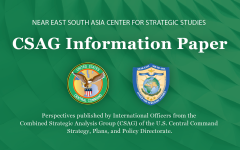Post-Maximum Pressure Campaign Rapprochement with Iran
February 19, 2021 2021-02-19 19:52Post-Maximum Pressure Campaign Rapprochement with Iran
By: Lt Col Farhan Ali, Pakistan Army, CSAG CCJ5
19 Feb 2021
Introduction:
The Trump Administration criticized President Obama’s Iran policy, particularly the Joint Comprehensive Plan of Action (JCPOA). President Trump described the JCPOA as a poorly conceived and one-sided agreement that disproportionally benefitted Iran and allowed it to continue its malign behavior in the region. In order to address this stated imbalance, President Trump withdrew the US from the JCPOA and subsequently, initiated a new policy to influence Iran’s behavior and force a new deal. At the center of this new US policy was the maximum pressure campaign (MPC). This paper will discuss MPC effectiveness to influence Iranian behavior and possible pathways for negotiations.
Key Points:
- Despite extreme financial pressure, Iran has yet to default or file bankruptcy, and Iranian malign behavior continues unabated.
- The maximum pressure campaign failed to force a behavioral change in Iran largely due to the US’ isolationist approach, and the Iranian regime’s resiliency, domestic food and energy resources, and exploitation of loopholes and black markets to avoid financial sanctions.
- The US’ plan to use snapback sanctions to isolate Iran from the world failed.
- The Abraham Accords and follow up high-tech weapons sales to Iran’s archrivals threaten Iranian national security and may cause the regime to take security measures that undermine regional stability.
- Iran continues to violate rules-based order as the international community increasingly phases Iran out of the systems and structures that comprise that order.
- A balanced and uniform diplomatic and military Middle East policy, broadly implemented without exception, may help stabilize the region.
- To best ensure long-term Middle East stability, global and regional stakeholders must build trust, improve communications, properly oversee agreement implementation, effectively redress grievances, and protect the process against spoilers’ actions.
The opinions and conclusions expressed herein are those of a number of international officers within the Combined Strategic Analysis Group (CSAG) and do not necessarily reflect the views of United States Central Command, not of the nations represented within the CSAG or any other governmental agency.



